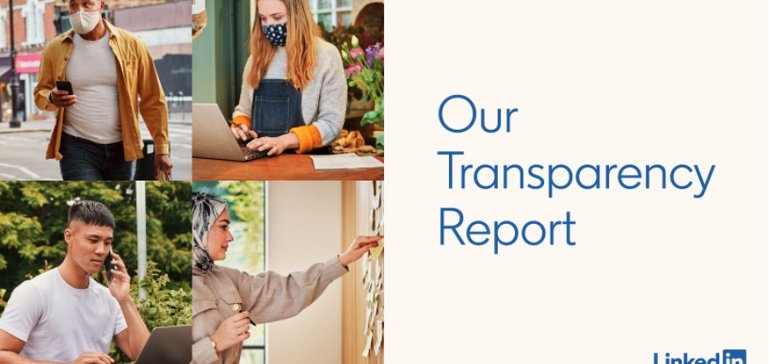SOCIAL
LinkedIn Shares Latest Update on Fake Account Detection, Scams, Government Requests and More

LinkedIn has published its latest Transparency Report, covering the period between January and June 2021, which outlines all of the content and account violations it detected and actioned in the period, along with government requests for information and more.
LinkedIn’s transparency reports highlight key usage trends, particularly in relation to topics being discussed in the app, as well as changes in the way that scammers and spammers are seeking to target users over time. And with LinkedIn usage rising, it’s worth noting these shifts.
First off, in terms of fake accounts, LinkedIn says that there’s been no increase in fake account prevalence, as detected by its systems.
LinkedIn reported 11.6 million detections at the registration stage in the preceding period as well, though it has seen a slight rise in the amount of fake profiles restricted proactively over time.
It’s difficult to say, definitively, how well LinkedIn is doing on this front, as it can only report on the accounts that it detects, so there’s no true percentage of fake profiles in the app. If LinkedIn doesn’t know about them, it can’t report on such, so it’s not entirely clear what impact its efforts are having on this element, overall, but the numbers have remained steady, which shows that LinkedIn’s detection systems are catching out many attempts to scam users with fake profiles.
In terms of spam and scam activity, LinkedIn saw a decline in the period, dropping from 91.9 million removals in the preceding quarter to 66.1 million. LinkedIn has actually seen this number declining over the last two years – though interesting to note that LinkedIn has also included an update which explains that:
“An earlier version of this report reflected that LinkedIn proactively removed 22.4 million spam and scams during the reporting period of July through December 2020. We have edited the report to accurately reflect that LinkedIn proactively removed 91.9 million spam and scams during such reporting period.”
Not sure what the error was there, but seems like a fairly significant discrepancy.
Also notable: Misinformation removals are on the rise.

Over the past three reporting periods, LinkedIn removed 23k posts for misinformation (Jan-Jun 2020), then 111k in the last report, up to 147k now. Violent/graphic content removals have also increased over time, and in both cases, that could simply reflect increasing usage of the app, and more people posting more often, while approaches to misinformation, particularly around COVID-19, have also shifted a lot in that time.
But it is interesting to note the trends, and consider their implications in the broader scope of what people are sharing to LinkedIn, and how LinkedIn is enforcing such.
Harassment and abusive content removals declined slightly in the period.
In terms of Government requests, LinkedIn also saw a rise in the period.

Though I suspect that’s supposed to be Jan-Jun 2021, in line with previous reporting periods.
The US submitted the most Government removal requests, which mostly relates to search warrants and subpoenas, followed by Germany, France and India.
Interestingly, China only submitted five requests in the period. Back in October, LinkedIn shut down its main platform in China due to ongoing challenges in dealing with local compliance requirements in the region.
There are some interesting trend insights here, relating to the ever-shifting regulatory changes and approaches that influence the broader social media landscape. For LinkedIn, which is steadily rising in usage as various regions look to get back on track, it’s interesting to note the broadening scope of user reports and issues, and how that reflects the expanded usage of the platform for a wider range of purposes.
Maintaining user safety is a challenge for all platforms, and going on this report, it does seem that LinkedIn’s systems are keeping pace with usage trends, for the most part. But fake accounts and violations remain a problem, and an ongoing challenge for the platform to contend with.
You can read LinkedIn’s full Transparency Report for January to June 2021 here.
Source link
SOCIAL
Snapchat Explores New Messaging Retention Feature: A Game-Changer or Risky Move?

In a recent announcement, Snapchat revealed a groundbreaking update that challenges its traditional design ethos. The platform is experimenting with an option that allows users to defy the 24-hour auto-delete rule, a feature synonymous with Snapchat’s ephemeral messaging model.
The proposed change aims to introduce a “Never delete” option in messaging retention settings, aligning Snapchat more closely with conventional messaging apps. While this move may blur Snapchat’s distinctive selling point, Snap appears convinced of its necessity.
According to Snap, the decision stems from user feedback and a commitment to innovation based on user needs. The company aims to provide greater flexibility and control over conversations, catering to the preferences of its community.
Currently undergoing trials in select markets, the new feature empowers users to adjust retention settings on a conversation-by-conversation basis. Flexibility remains paramount, with participants able to modify settings within chats and receive in-chat notifications to ensure transparency.
Snapchat underscores that the default auto-delete feature will persist, reinforcing its design philosophy centered on ephemerality. However, with the app gaining traction as a primary messaging platform, the option offers users a means to preserve longer chat histories.
The update marks a pivotal moment for Snapchat, renowned for its disappearing message premise, especially popular among younger demographics. Retaining this focus has been pivotal to Snapchat’s identity, but the shift suggests a broader strategy aimed at diversifying its user base.
This strategy may appeal particularly to older demographics, potentially extending Snapchat’s relevance as users age. By emulating features of conventional messaging platforms, Snapchat seeks to enhance its appeal and broaden its reach.
Yet, the introduction of message retention poses questions about Snapchat’s uniqueness. While addressing user demands, the risk of diluting Snapchat’s distinctiveness looms large.
As Snapchat ventures into uncharted territory, the outcome of this experiment remains uncertain. Will message retention propel Snapchat to new heights, or will it compromise the platform’s uniqueness?
Only time will tell.
SOCIAL
Catering to specific audience boosts your business, says accountant turned coach

While it is tempting to try to appeal to a broad audience, the founder of alcohol-free coaching service Just the Tonic, Sandra Parker, believes the best thing you can do for your business is focus on your niche. Here’s how she did just that.
When running a business, reaching out to as many clients as possible can be tempting. But it also risks making your marketing “too generic,” warns Sandra Parker, the founder of Just The Tonic Coaching.
“From the very start of my business, I knew exactly who I could help and who I couldn’t,” Parker told My Biggest Lessons.
Parker struggled with alcohol dependence as a young professional. Today, her business targets high-achieving individuals who face challenges similar to those she had early in her career.
“I understand their frustrations, I understand their fears, and I understand their coping mechanisms and the stories they’re telling themselves,” Parker said. “Because of that, I’m able to market very effectively, to speak in a language that they understand, and am able to reach them.”Â
“I believe that it’s really important that you know exactly who your customer or your client is, and you target them, and you resist the temptation to make your marketing too generic to try and reach everyone,” she explained.
“If you speak specifically to your target clients, you will reach them, and I believe that’s the way that you’re going to be more successful.
Watch the video for more of Sandra Parker’s biggest lessons.
SOCIAL
Instagram Tests Live-Stream Games to Enhance Engagement

Instagram’s testing out some new options to help spice up your live-streams in the app, with some live broadcasters now able to select a game that they can play with viewers in-stream.
As you can see in these example screens, posted by Ahmed Ghanem, some creators now have the option to play either “This or That”, a question and answer prompt that you can share with your viewers, or “Trivia”, to generate more engagement within your IG live-streams.
That could be a simple way to spark more conversation and interaction, which could then lead into further engagement opportunities from your live audience.
Meta’s been exploring more ways to make live-streaming a bigger consideration for IG creators, with a view to live-streams potentially catching on with more users.
That includes the gradual expansion of its “Stars” live-stream donation program, giving more creators in more regions a means to accept donations from live-stream viewers, while back in December, Instagram also added some new options to make it easier to go live using third-party tools via desktop PCs.
Live streaming has been a major shift in China, where shopping live-streams, in particular, have led to massive opportunities for streaming platforms. They haven’t caught on in the same way in Western regions, but as TikTok and YouTube look to push live-stream adoption, there is still a chance that they will become a much bigger element in future.
Which is why IG is also trying to stay in touch, and add more ways for its creators to engage via streams. Live-stream games is another element within this, which could make this a better community-building, and potentially sales-driving option.
We’ve asked Instagram for more information on this test, and we’ll update this post if/when we hear back.
-

 PPC6 days ago
PPC6 days ago19 Best SEO Tools in 2024 (For Every Use Case)
-
SEARCHENGINES7 days ago
Daily Search Forum Recap: April 17, 2024
-
SEARCHENGINES5 days ago
Daily Search Forum Recap: April 19, 2024
-
SEARCHENGINES6 days ago
Daily Search Forum Recap: April 18, 2024
-

 MARKETING6 days ago
MARKETING6 days agoEcommerce evolution: Blurring the lines between B2B and B2C
-

 WORDPRESS5 days ago
WORDPRESS5 days agoHow to Make $5000 of Passive Income Every Month in WordPress
-

 SEO6 days ago
SEO6 days ago2024 WordPress Vulnerability Report Shows Errors Sites Keep Making
-

 WORDPRESS6 days ago
WORDPRESS6 days ago10 Amazing WordPress Design Resouces – WordPress.com News















You must be logged in to post a comment Login